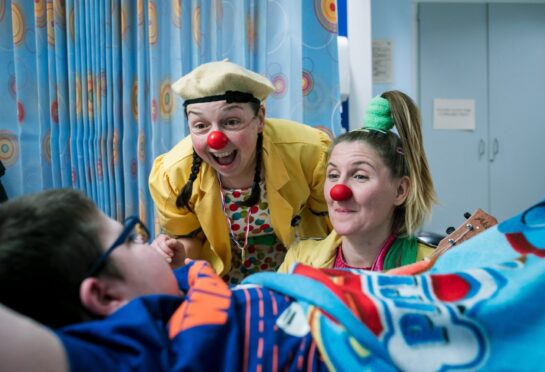
On Ward 1C of the Royal Hospital for Children in Glasgow, laughter, singing and the twanging of a ukulele drowns out the usual sound of beeping monitors and machines.
Today, a very special visit from Dr Go Go and Dr Wallop, two Clowndoctors from the Scottish charity, Hearts & Minds, offers young patients a welcome break from tests, checks and treatments.
With their red noses and bright yellow coats, these doctors specialise in light relief.
On their regular visits, clowning around on the wards isn’t frowned upon but encouraged and serves to brighten the day of children and their families and help ease the anxiety and stress of being in hospital.
Dr Go Go and Dr Wallop chat, joke and sing as they skip and dance around a shared room, causing delighted kids to smile, laugh and even snap a selfie from their beds. When they get to Mackenzie Cameron, his eyes light up in recognition.
Having been in and out of hospital for years, these visits are a regular highlight for the 14-year-old.
“Mac always loves to take part in the fun that the Clowndoctors bring to the wards. He loves them so much that he went through the training to become Dr Disney,” said Mackenzie’s dad, Richard.
“He always looks forward to their visits. Those 10 minutes or so can be enough to take his mind elsewhere – away from the medical side of things.”
A meaningful connection
While their outfits are fun and their demeanour is open, empathetic and cheerful, the Clowndoctors don’t just seek to make children laugh and smile.
The aim, says Doctor Go Go – Sita Pieraccini – is to create a positive encounter and reinforce the idea that a stay in hospital, whether for an afternoon or long-term, doesn’t need to be sad or scary.
“It’s not just about getting a smile or a laugh, which is always great, but more making a meaningful connection with a child and acting as a distraction,” says Sita, who was inspired to join the Clowndoctors ranks by her big sister Carmen, aka Dr Squeegie, eight years ago.
“I love ward visits where we can feel that we’ve completely changed the energy of the room and are like a breath of fresh air. Even if kids don’t want to interact with us and say ‘not today’ that’s also great because it’s giving them agency.” Now in its 25th year, the Clowndoctor initiative, which started in Edinburgh Sick Kids Hospital (now the Royal Hospital for Children and Young People) in 1999, now operates in hospitals across Glasgow, Edinburgh and Dundee.
The Clowndoctors also visit children’s hospices across the country and six schools for children with additional learning needs, where they encourage therapeutic play.
More recently, the Clowndoctors have been visiting families on neo-natal wards in Edinburgh to help ease the anxiety of new parents of premature or unwell babies. The charity also created a virtual Clowndoctor programme that children having surgery can watch using VR goggles to help ease their anxiety.
“Each Clowndoctor visit is unique and often tailored to the individual child’s needs,” explains the charity’s CEO, Sean Donnelly. “Using basic clowning principles, they could create calm, gentle actions, rhythms or sounds to soothe a two-year-old, or more robust or slapstick routines for an older child who’s perhaps frustrated that they’ve been in hospital for so long.
“Children may be going through painful, scary or upsetting procedures in an environment which is abnormal. Bringing the Clowndoctors into that gives them a sense of agency, for example, they could blow a bubble that sends a Clowndoctor flying across the room.
“It also brings a sense of fun and playfulness within that hospital environment where play opportunities are limited. Seeing a family member who has been upset or stressed smile and laugh can be beneficial.”
Laughter is the best medicine
Sean adds that there is weight to the idea that laughter is the best medicine. He says: “Endorphins help the healing process and hospitals can seem less scary when filled with colour, laughter and joy.” Hearts & Minds uses playfulness, empathy and kindness to help young and old people overcome any anxiety, fear, confusion and sadness caused by their situations or conditions.
The charity also runs a similar Elderflower project to bring joy, laughter and social connection to people living with dementia.
The feedback from young patients and their parents is positive and heart-warming, says Fiona Manson, better known as Dr Groovy when she’s in costume, who has been performing with the Clowndoctors for 10 years.
“Parents often say their child was having a rough day until we came in or that they weren’t speaking all morning but after our visit, they were chatty or got out of bed for the first time that day,” says Fiona.
The charity’s team of 20 Clowndoctors are all professional performers who work part-time.
When Sita isn’t wearing her red nose, the Glasgow-based performer, theatre-maker and musician swaps her ukulele for a bass guitar to perform with her band Teen Canteen across the country. Fiona also runs her own theatre company, The Polar Bears.
“Kids can be a hard audience but this works so well because clowns are coming from a place of naivety, they love to make mistakes,” adds Fiona.
“We want to meet the kids on their level, so as soon as we put on our red nose we’re in it with them. Sometimes them being able to inform us about why they’re in hospital or about a treatment or surgery they need to have can empower them and demystify the whole process.
“Helping to slowly build up trust can pave the way for easier interactions between a child, and their medical staff, and sometimes we can also distract a child when they are getting a procedure done.”
Hearts & Minds was among the first organisations in Europe to introduce the practice of clowning in hospitals, a concept that originated in New York in the ‘80s.
Today, it is one of 20 members of the European Federation of Clowning in Healthcare and will host the body’s annual conference in Edinburgh later this year.
“We aim to be on every children’s ward in Scotland and in every school with children with additional support needs that require us, and to eventually be mainstream enough that any child in need of our support can get it,” adds Simon.
25th anniversary
To mark its 25 years of therapeutic clowning in Scottish hospitals, Hearts & Minds has teamed up with Scottish comedian and Scot Squad star, Chris Forbes, who aims to raise awareness and funding for the charity through a video and several fundraising stand-up shows.
“I saw first-hand how much joy and happiness the Clowndoctors brought to children and families in their darkest moments. It’s such a precious gift,” Forbes said.
Besides the constant battle to secure vital funding, one of the greatest challenges Hearts & Minds has faced was the social distancing rules enforced across hospitals during the Coronavirus pandemic. The Clowndoctors instead entertained children via regular video calls and occasional doorstep visits.
“We missed being on the wards but made it work,” recalls Fiona. “I met a kid in Robin House Children’s Hospice the other week who I’ve not seen since the pandemic. His mum said we got them through the pandemic, and those video calls helped us too.”
Of being back to regular ward rounds as Dr Groovy, she adds, “Whether it’s a child, patient or carer, if we can improve anyone’s day and make it just a little bit brighter, we’ve done our job.”
Find out more at heartsminds.org.uk

Enjoy the convenience of having The Sunday Post delivered as a digital ePaper straight to your smartphone, tablet or computer.
Subscribe for only £5.49 a month and enjoy all the benefits of the printed paper as a digital replica.
Subscribe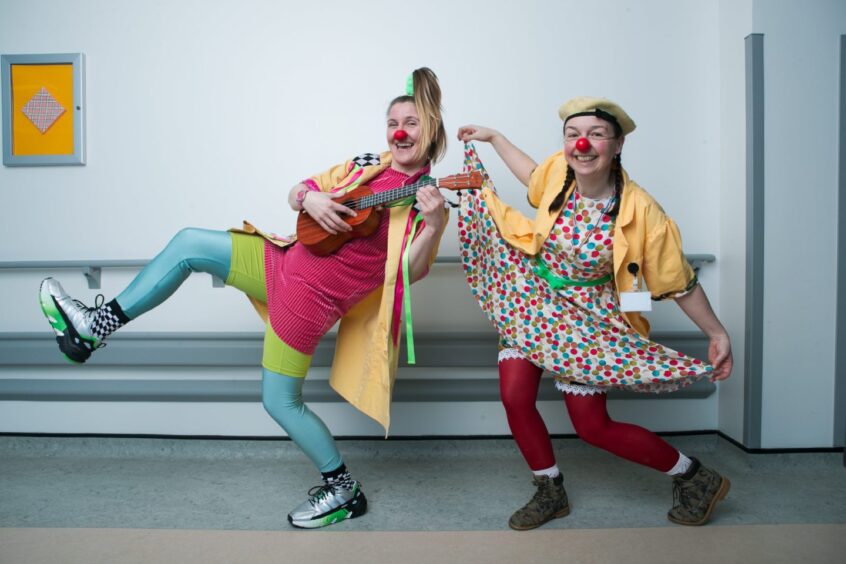 © Andrew Cawley
© Andrew Cawley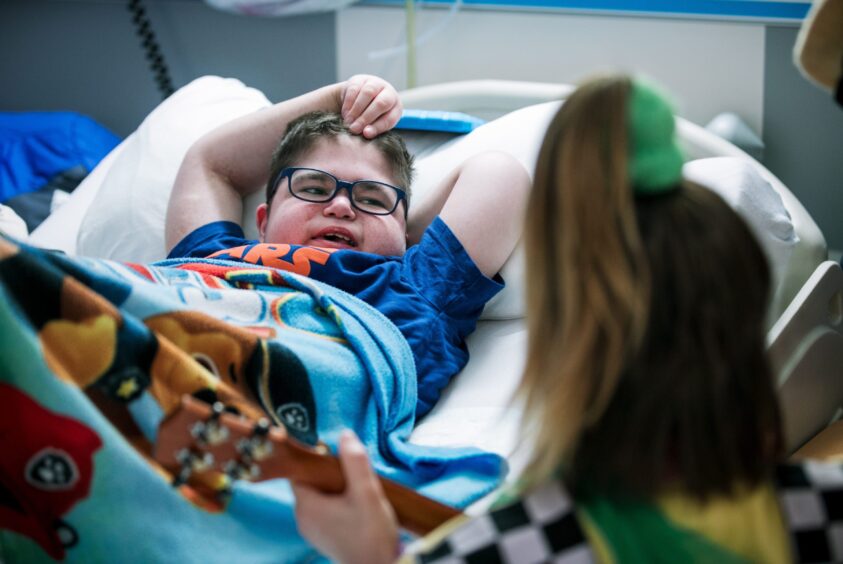 © Andrew Cawley
© Andrew Cawley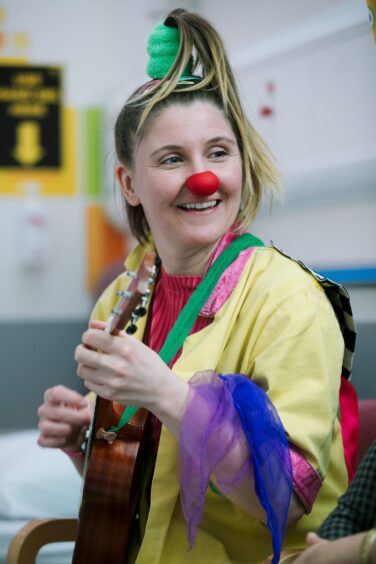 © Andrew Cawley
© Andrew Cawley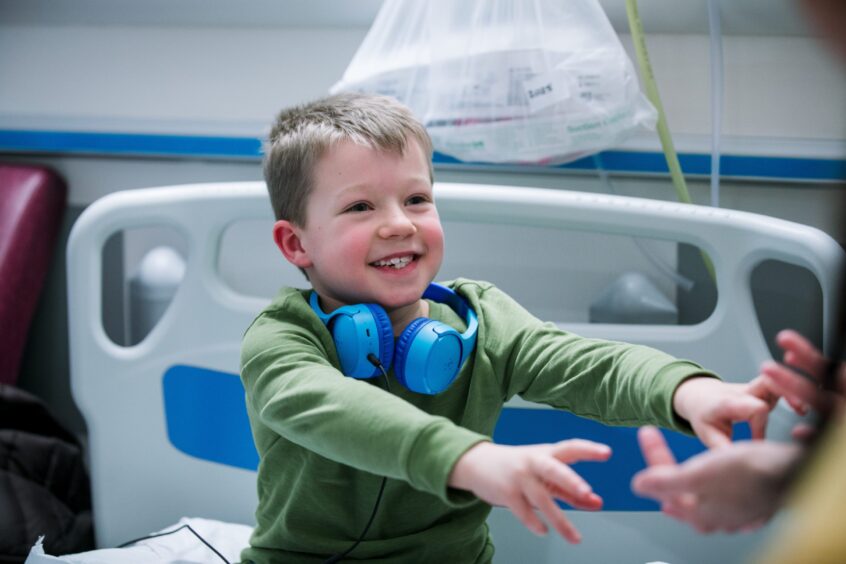 © Andrew Cawley
© Andrew Cawley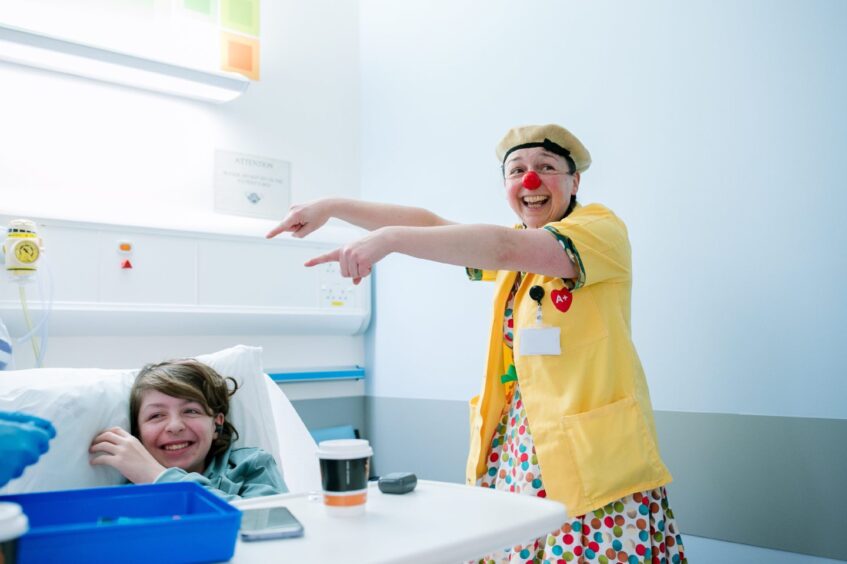 © Andrew Cawley
© Andrew Cawley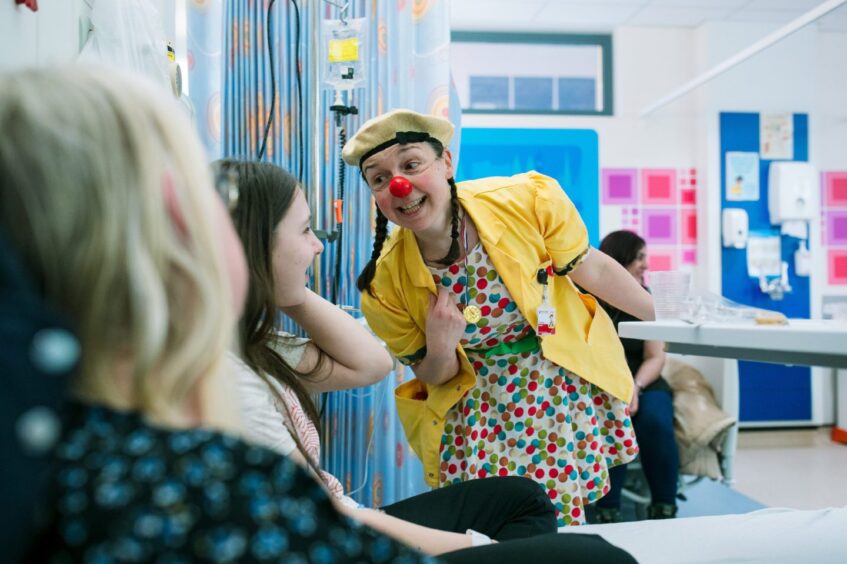 © Andrew Cawley
© Andrew Cawley